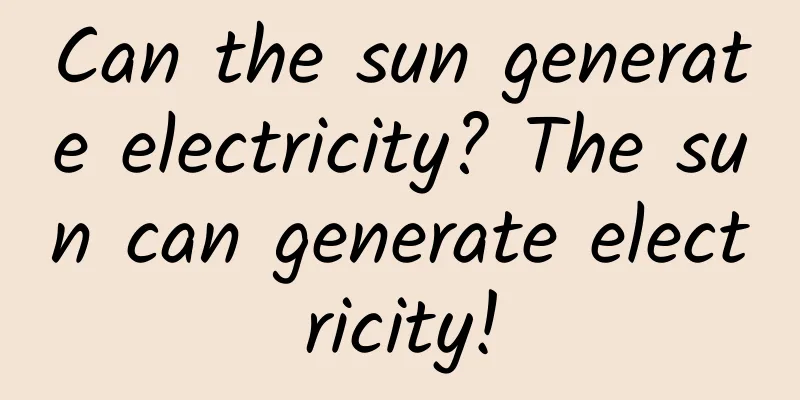Can the sun generate electricity? The sun can generate electricity!

|
The progress and development of society cannot be separated from the promotion and help of "energy". Especially after the two industrial revolutions, people have become more aware of the importance of energy development. Just imagine, if there is no energy, will our life still be so colorful? However, with the rapid changes in society, traditional energy represented by fossil energy (such as coal, oil, etc.) is becoming increasingly difficult to meet the growing energy demand due to problems such as long regeneration cycle, declining reserves and quality year by year. Therefore, scientists have turned their attention to the development of renewable and sustainable new energy sources, and an "energy treasure" has come into their sight - the sun. Inspiration from photosynthesis in plants: Using solar energy to generate electricity We all know that almost all the energy available to all living things on Earth comes from plant photosynthesis. Schematic diagram of photosynthesis (Source: http://www.1010jiajiao.com/czsw/shiti_id_d623a67f6a9c974e1647ce187eb3f72a) Photosynthesis in plants refers to the biological process of synthesizing sugars in plant chloroplasts using carbon dioxide and water as raw materials under light conditions. Since sugars can generate energy during metabolism, solar energy is stored in this way. However, this energy generally needs to be converted before it can become the electricity we commonly use, so it is difficult for us to use it directly. In addition, the principles of physics tell us that the energy conversion process will inevitably lead to energy loss. Therefore, the issue of directly converting solar energy into electrical energy has been put on the agenda. So, can solar energy be directly converted into electrical energy? What factors are related to this conversion process? This was a great proposition for scientists in the early 19th century. Fortunately, this problem made a great breakthrough at the end of the 19th century. He has the "strongest brain" and discovered the secrets of light and electricity In 1887, the famous physicist Hertz (the unit of frequency is named after him today) accidentally discovered during a study that when light shines on the surface of certain materials, the electrical properties of the materials will change. Subsequent studies have shown that this is caused by the generation of electron flow, so this phenomenon is called the "photoelectric effect." Schematic diagram of the photoelectric effect (Image source: http://img.mp.itc.cn/upload/20160511/076aa3518f444e0c902e391fe7613d1e_th.jpg) You know, the operating principle of the world needs to conform to the principles of physics. At that time, the classical physics principles established by Newton dominated people's thinking. This principle believes that light is a wave transmitted in the medium of ether (a substance imagined by the ancient Greek philosopher Aristotle, which was borrowed by physicists in the 19th century to refer to the medium for light propagation) (you can imagine the scene of a stone thrown into a lake, and the surface of the lake is rippling with circles of ripples transmitted outward with water as the medium), and the energy of the wave is related to the amplitude (vibration amplitude) (the amplitude of the light wave is the intensity of the light). This seems to be very common sense. As you can imagine, the sun is not strong in winter, and you feel warm when it shines on your body; while in summer, the sun is glaring, and if you don't pay attention to protecting your skin, you may get sunburned. Therefore, under classical physics, whether the photoelectric effect can occur depends on the intensity of light. However, this theory contradicts a series of experimental results at the time. Research has shown that for the same substance, some colors of light will not produce the photoelectric effect regardless of the intensity, while some colors of light can generate current even at very low intensities. Classical physics is in crisis, and a storm sweeping the entire scientific community is brewing. Storms mean destruction, but they also bring rebirth. One after another, great scientists cut through the waves in the center of the storm, and classical physics set sail again under the dual revisions of relativistic physics and quantum physics. The master who solved the problem of photoelectric effect was Albert Einstein, whom we are all familiar with. Einstein is widely known for establishing the theory of relativity, but what you may not know is that such a great scientist almost did not win the Nobel Prize, which is considered the highest honor in the scientific community (the Nobel Prize is never awarded for controversial discoveries, and the discussion and controversy over the theory of relativity has not stopped to this day). Einstein won the 1921 Nobel Prize in Physics thanks to his creative explanation of the photoelectric effect. He proposed that light is composed of photons, and the essence of photons is energy packets . The energy contained in each energy packet is related to its frequency (the number of changes within a unit time (1s)). Therefore , whether light can produce electrons when it shines on an object depends entirely on the energy (frequency) of the energy packet (photon), and has nothing to do with the number of energy packets (light intensity). How do "sandwich" solar cells work? We have introduced the discovery process of the photoelectric effect and how to produce it. So, how can we use the generated electrons? This involves another concept - energy level transition. Schematic diagram of energy level transition (Image source: Qingdao Institute of Bioenergy and Process Technology, Carbon-based Energy Conversion Materials Research Group) An atom is composed of a nucleus and electrons outside the nucleus. The electrons outside the nucleus are not arranged randomly, but are arranged in layers according to the principles of physics. The electrons close to the nucleus have low energy, and the farther away from the nucleus, the higher the energy. The electrons in different layers have different energies, and these energy values are also called "energy levels." Under normal conditions, the electrons outside the nucleus always tend to be arranged in the form with the lowest total energy. We call such electrons in the "ground state". When the atoms in the ground state receive some form of energy (such as photons), they will spontaneously transfer to a higher energy level. This is an energy level transition. The electrons after the transition are called in the "excited state". Unfortunately, excited electrons are not stable and tend to jump to lower energy levels. The excess energy of the electrons is dissipated in the form of light energy or heat energy. No, the energy is just dissipated like that, but we still don’t get any electricity? Don’t worry. In order to conduct the current generated by the photoelectric effect, we need to build a suitable device structure , which is what we often call a solar cell (as shown in Figure 2). The device structure is shaped like a sandwich, with the active layer with photoelectric effect sandwiched between the electron transport layer and the hole transport layer (the local electron-deficient part formed after electron transition is called a hole), and the two ends are electrode materials, generally metal and indium tin oxide (ITO). When atoms in the ground state receive some form of energy (such as photons), they will spontaneously transfer to a higher energy level. This is an energy level transition, and the electrons after the transition are said to be in an "excited state" . Because the excited state energy level of the electron transport layer is slightly lower than that of the active layer, the excited state electrons in the active layer are easily transferred to the electron transport layer instead of returning to the ground state of the active layer; while the ground state of the hole transport layer has slightly higher energy than the ground state electrons in the active layer, and the electrons tend to transfer to the ground state of the active layer. This is like setting up small steps for electrons, so that they can step over them just by "lifting their feet" instead of making a difficult jump (transition), so the whole process is easy to achieve. Through the effective cooperation of the electron transport layer and the hole transport layer, the entire device forms a complete circuit, and the electrons generated by the active layer can be exported and used by us. Schematic diagram of common solar cell device structure (Image source: Qingdao Institute of Bioenergy and Process Technology, Carbon-based Energy Conversion Materials Research Group) After the conversion process, we finally get electricity directly from the sun, and this is the principle of solar cells. The pace of scientific exploration never stops, and it is precisely because of the great research and discoveries of these great scientists that the problem of energy shortage has been effectively alleviated and helped mankind move towards a sustainable future. |
Recommend
2019 Tik Tok promotion and operation strategy!
20% of the videos account for 80% of the views, b...
E-commerce search traffic allocation strategy
For major e-commerce platforms, search is an indi...
Is brewing tea in a thermos cup toxic and carcinogenic? What food safety experts say
"When people reach middle age, they can'...
Amazon's super practical full-case course: Say no to blindly distribute goods in large quantities, and get thousands of orders a day without any problem
Amazon's super practical full-case course: re...
App promotion|Any product is a business
1. What is the product? At the end of the day, th...
Li Yuan Introduction: Where is the nofollow tag applicable?
When doing SEO optimization, in addition to some ...
Users are not a cover! Let’s talk about some mistakes we are prone to and are currently making with our users!
Regarding this topic, I will only talk about a fe...
10 Key Steps to Turn Your Mobile App Idea into Reality
Many individuals and companies come up with new m...
Douyin recommendation review mechanism, see here!
The number of monthly active users of Douyin worl...
Case analysis: Comments on the operation methods of 8 special communities
There are various forms of case communities , and...
A nucleic acid sampling worker in Beijing was diagnosed! Experts urgently remind that masks should be worn like this →
According to the Beijing Municipal Health Commiss...
TCL's innovative development path empowered by AI: comprehensive transformation from terminals to industries
As another wave of technology after the Internet,...
Have Huawei and Xiaomi, the two mobile phone lovers, become lifelong enemies?
When Xiaomi was close to becoming a legend in 201...
Is the world chaotic? Wandering between order and disorder
Yang Mingzhe Introduction: Imagine we throw a sto...
Li Guoqing opposes giving extra points to the children of medical staff fighting the epidemic. Is it reasonable to give extra points to the children of medical staff fighting the epidemic?
Recently, Li Guoqing, the founder of Dangdang.com...









